Nursing Project: Addressing Nurse Fatigue and Stress in Healthcare
VerifiedAdded on 2023/06/04
|21
|5728
|380
Project
AI Summary
This nursing project addresses the critical issue of nurse fatigue and stress resulting from long shift hours in a surgical department setting. The project utilizes the Wadula workbook to develop an initiative aimed at supporting nurses in managing their stress and fatigue, with the ultimate goal of preventing clinical errors and improving overall well-being. The proposal is justified by evidence linking long shifts to increased clinical errors, burnout, and reduced job satisfaction among nurses. Key stakeholders include nurses, supervisors, doctors, hospital administrators, and wellness consultants. Proposed solutions involve stress management activities, time management techniques, adequate rest and breaks, lifestyle improvements, and a focus on work-life balance. The project aims to engage stakeholders in a collaborative effort to implement effective strategies, while acknowledging potential challenges related to resource allocation and administrative support. The project emphasizes the importance of empirical evidence and quantitative data to support the proposed changes and ensure a positive impact on nurse performance and job satisfaction.
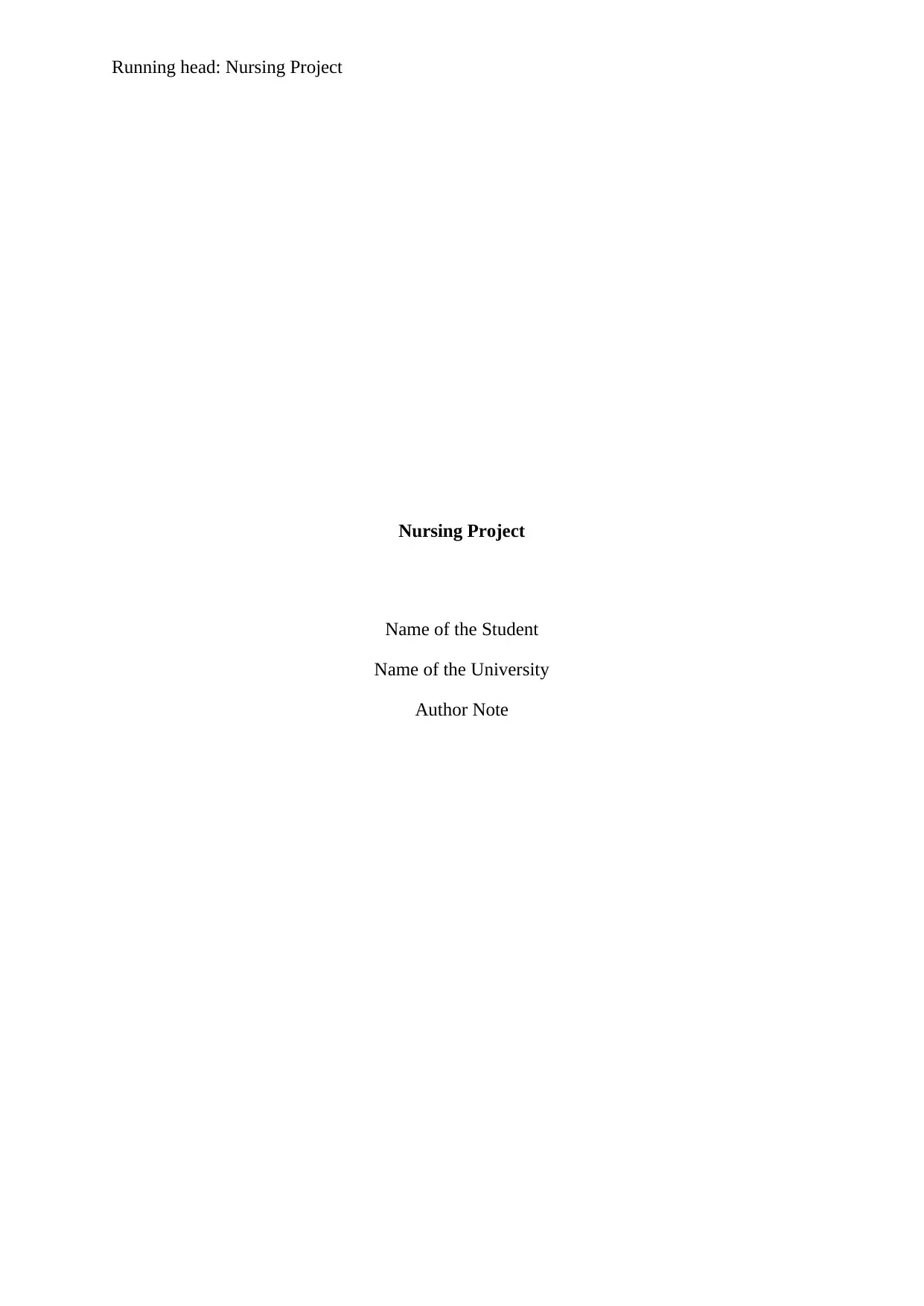
Running head: Nursing Project
Nursing Project
Name of the Student
Name of the University
Author Note
Nursing Project
Name of the Student
Name of the University
Author Note
Paraphrase This Document
Need a fresh take? Get an instant paraphrase of this document with our AI Paraphraser
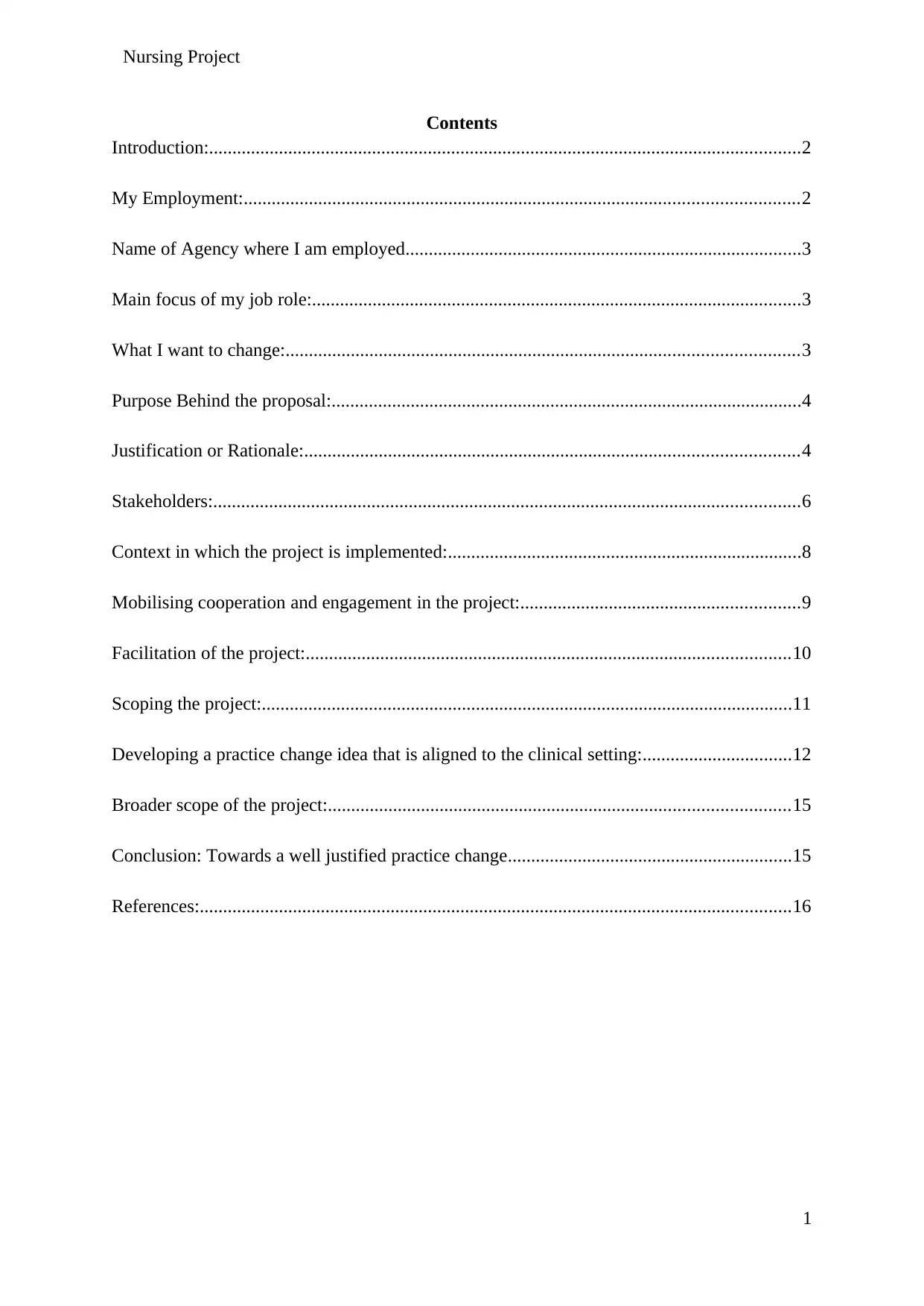
Nursing Project
Contents
Introduction:...............................................................................................................................2
My Employment:.......................................................................................................................2
Name of Agency where I am employed.....................................................................................3
Main focus of my job role:.........................................................................................................3
What I want to change:..............................................................................................................3
Purpose Behind the proposal:.....................................................................................................4
Justification or Rationale:..........................................................................................................4
Stakeholders:..............................................................................................................................6
Context in which the project is implemented:............................................................................8
Mobilising cooperation and engagement in the project:............................................................9
Facilitation of the project:........................................................................................................10
Scoping the project:..................................................................................................................11
Developing a practice change idea that is aligned to the clinical setting:................................12
Broader scope of the project:...................................................................................................15
Conclusion: Towards a well justified practice change.............................................................15
References:...............................................................................................................................16
1
Contents
Introduction:...............................................................................................................................2
My Employment:.......................................................................................................................2
Name of Agency where I am employed.....................................................................................3
Main focus of my job role:.........................................................................................................3
What I want to change:..............................................................................................................3
Purpose Behind the proposal:.....................................................................................................4
Justification or Rationale:..........................................................................................................4
Stakeholders:..............................................................................................................................6
Context in which the project is implemented:............................................................................8
Mobilising cooperation and engagement in the project:............................................................9
Facilitation of the project:........................................................................................................10
Scoping the project:..................................................................................................................11
Developing a practice change idea that is aligned to the clinical setting:................................12
Broader scope of the project:...................................................................................................15
Conclusion: Towards a well justified practice change.............................................................15
References:...............................................................................................................................16
1
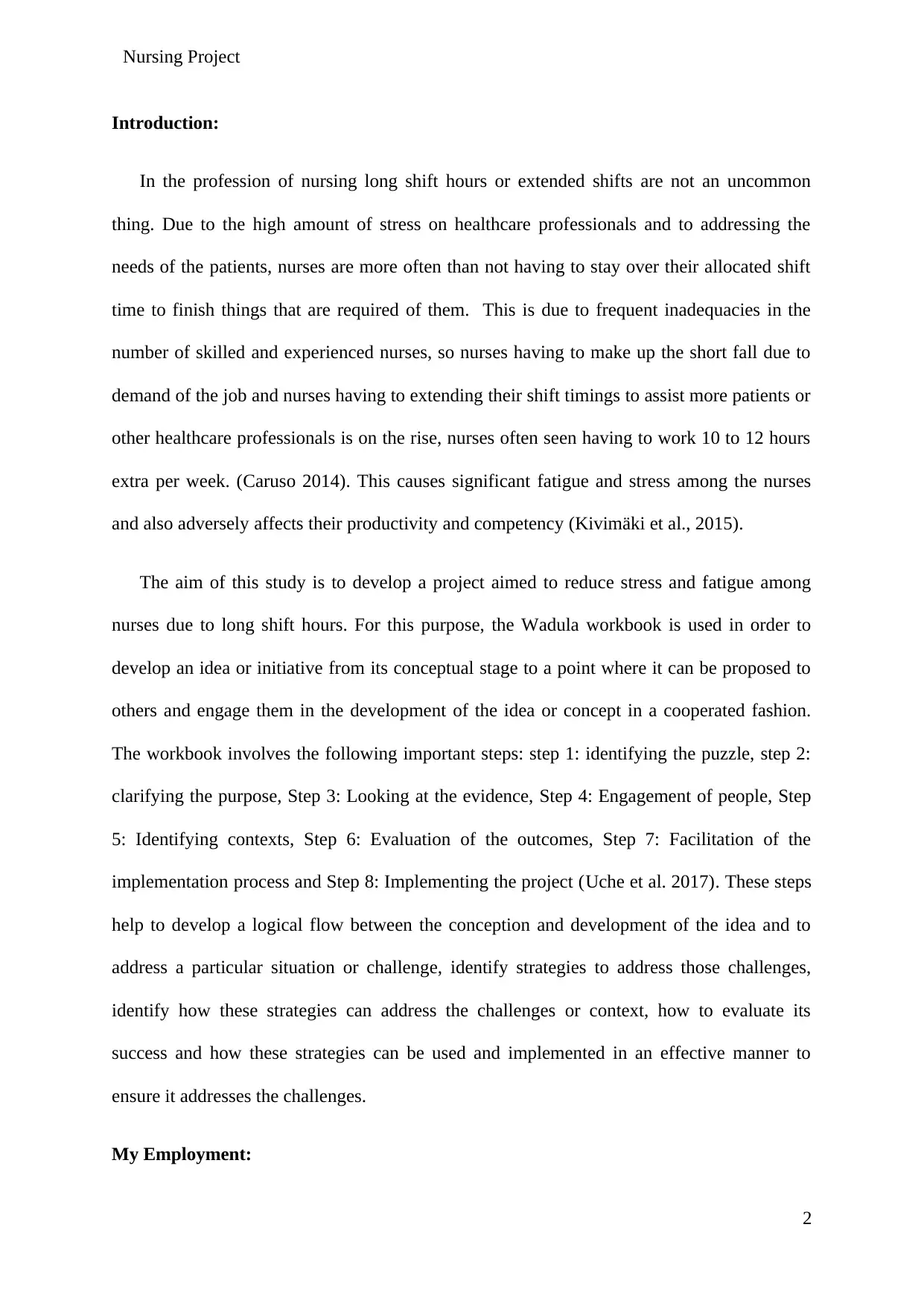
Nursing Project
Introduction:
In the profession of nursing long shift hours or extended shifts are not an uncommon
thing. Due to the high amount of stress on healthcare professionals and to addressing the
needs of the patients, nurses are more often than not having to stay over their allocated shift
time to finish things that are required of them. This is due to frequent inadequacies in the
number of skilled and experienced nurses, so nurses having to make up the short fall due to
demand of the job and nurses having to extending their shift timings to assist more patients or
other healthcare professionals is on the rise, nurses often seen having to work 10 to 12 hours
extra per week. (Caruso 2014). This causes significant fatigue and stress among the nurses
and also adversely affects their productivity and competency (Kivimäki et al., 2015).
The aim of this study is to develop a project aimed to reduce stress and fatigue among
nurses due to long shift hours. For this purpose, the Wadula workbook is used in order to
develop an idea or initiative from its conceptual stage to a point where it can be proposed to
others and engage them in the development of the idea or concept in a cooperated fashion.
The workbook involves the following important steps: step 1: identifying the puzzle, step 2:
clarifying the purpose, Step 3: Looking at the evidence, Step 4: Engagement of people, Step
5: Identifying contexts, Step 6: Evaluation of the outcomes, Step 7: Facilitation of the
implementation process and Step 8: Implementing the project (Uche et al. 2017). These steps
help to develop a logical flow between the conception and development of the idea and to
address a particular situation or challenge, identify strategies to address those challenges,
identify how these strategies can address the challenges or context, how to evaluate its
success and how these strategies can be used and implemented in an effective manner to
ensure it addresses the challenges.
My Employment:
2
Introduction:
In the profession of nursing long shift hours or extended shifts are not an uncommon
thing. Due to the high amount of stress on healthcare professionals and to addressing the
needs of the patients, nurses are more often than not having to stay over their allocated shift
time to finish things that are required of them. This is due to frequent inadequacies in the
number of skilled and experienced nurses, so nurses having to make up the short fall due to
demand of the job and nurses having to extending their shift timings to assist more patients or
other healthcare professionals is on the rise, nurses often seen having to work 10 to 12 hours
extra per week. (Caruso 2014). This causes significant fatigue and stress among the nurses
and also adversely affects their productivity and competency (Kivimäki et al., 2015).
The aim of this study is to develop a project aimed to reduce stress and fatigue among
nurses due to long shift hours. For this purpose, the Wadula workbook is used in order to
develop an idea or initiative from its conceptual stage to a point where it can be proposed to
others and engage them in the development of the idea or concept in a cooperated fashion.
The workbook involves the following important steps: step 1: identifying the puzzle, step 2:
clarifying the purpose, Step 3: Looking at the evidence, Step 4: Engagement of people, Step
5: Identifying contexts, Step 6: Evaluation of the outcomes, Step 7: Facilitation of the
implementation process and Step 8: Implementing the project (Uche et al. 2017). These steps
help to develop a logical flow between the conception and development of the idea and to
address a particular situation or challenge, identify strategies to address those challenges,
identify how these strategies can address the challenges or context, how to evaluate its
success and how these strategies can be used and implemented in an effective manner to
ensure it addresses the challenges.
My Employment:
2
⊘ This is a preview!⊘
Do you want full access?
Subscribe today to unlock all pages.

Trusted by 1+ million students worldwide
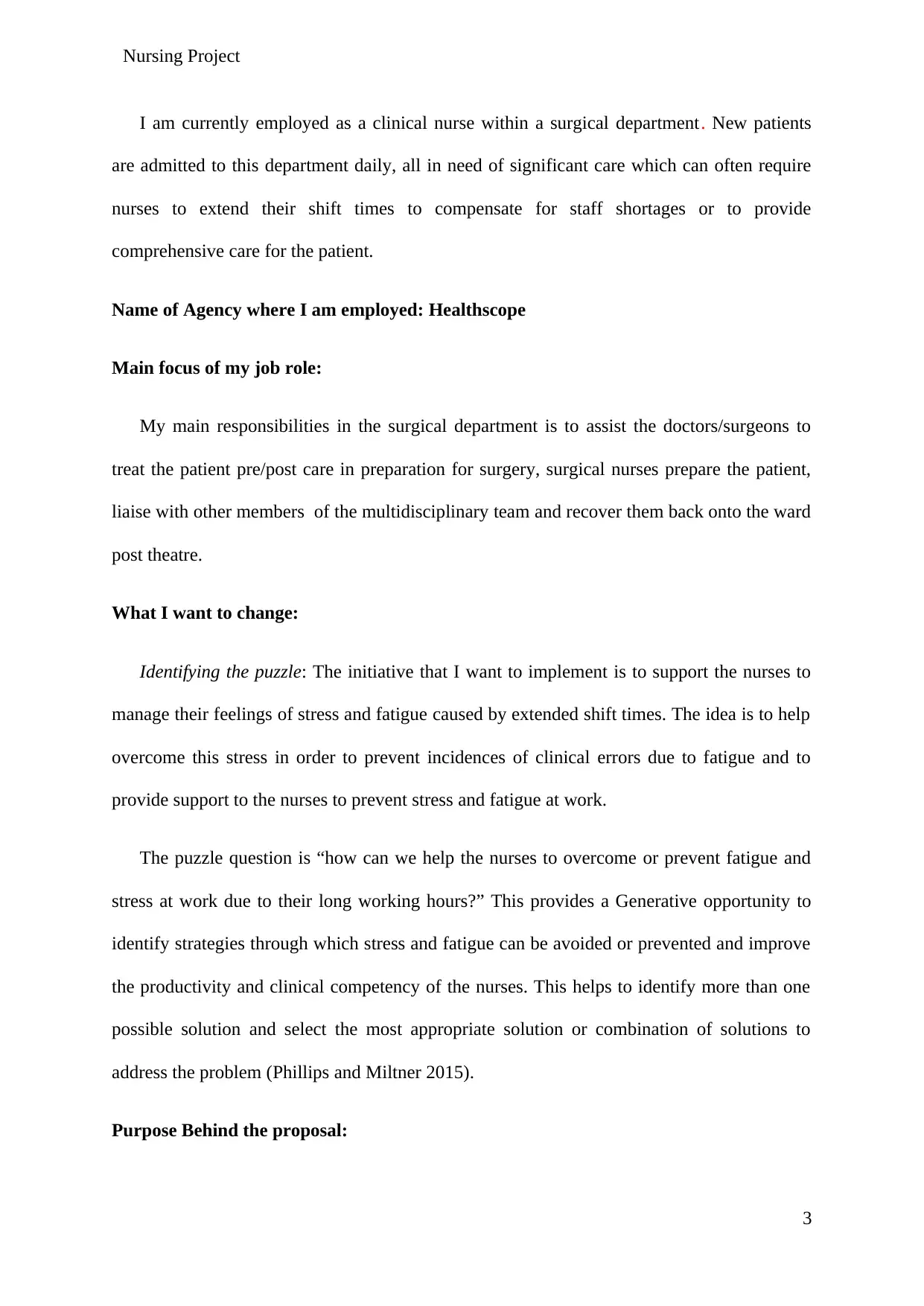
Nursing Project
I am currently employed as a clinical nurse within a surgical department. New patients
are admitted to this department daily, all in need of significant care which can often require
nurses to extend their shift times to compensate for staff shortages or to provide
comprehensive care for the patient.
Name of Agency where I am employed: Healthscope
Main focus of my job role:
My main responsibilities in the surgical department is to assist the doctors/surgeons to
treat the patient pre/post care in preparation for surgery, surgical nurses prepare the patient,
liaise with other members of the multidisciplinary team and recover them back onto the ward
post theatre.
What I want to change:
Identifying the puzzle: The initiative that I want to implement is to support the nurses to
manage their feelings of stress and fatigue caused by extended shift times. The idea is to help
overcome this stress in order to prevent incidences of clinical errors due to fatigue and to
provide support to the nurses to prevent stress and fatigue at work.
The puzzle question is “how can we help the nurses to overcome or prevent fatigue and
stress at work due to their long working hours?” This provides a Generative opportunity to
identify strategies through which stress and fatigue can be avoided or prevented and improve
the productivity and clinical competency of the nurses. This helps to identify more than one
possible solution and select the most appropriate solution or combination of solutions to
address the problem (Phillips and Miltner 2015).
Purpose Behind the proposal:
3
I am currently employed as a clinical nurse within a surgical department. New patients
are admitted to this department daily, all in need of significant care which can often require
nurses to extend their shift times to compensate for staff shortages or to provide
comprehensive care for the patient.
Name of Agency where I am employed: Healthscope
Main focus of my job role:
My main responsibilities in the surgical department is to assist the doctors/surgeons to
treat the patient pre/post care in preparation for surgery, surgical nurses prepare the patient,
liaise with other members of the multidisciplinary team and recover them back onto the ward
post theatre.
What I want to change:
Identifying the puzzle: The initiative that I want to implement is to support the nurses to
manage their feelings of stress and fatigue caused by extended shift times. The idea is to help
overcome this stress in order to prevent incidences of clinical errors due to fatigue and to
provide support to the nurses to prevent stress and fatigue at work.
The puzzle question is “how can we help the nurses to overcome or prevent fatigue and
stress at work due to their long working hours?” This provides a Generative opportunity to
identify strategies through which stress and fatigue can be avoided or prevented and improve
the productivity and clinical competency of the nurses. This helps to identify more than one
possible solution and select the most appropriate solution or combination of solutions to
address the problem (Phillips and Miltner 2015).
Purpose Behind the proposal:
3
Paraphrase This Document
Need a fresh take? Get an instant paraphrase of this document with our AI Paraphraser
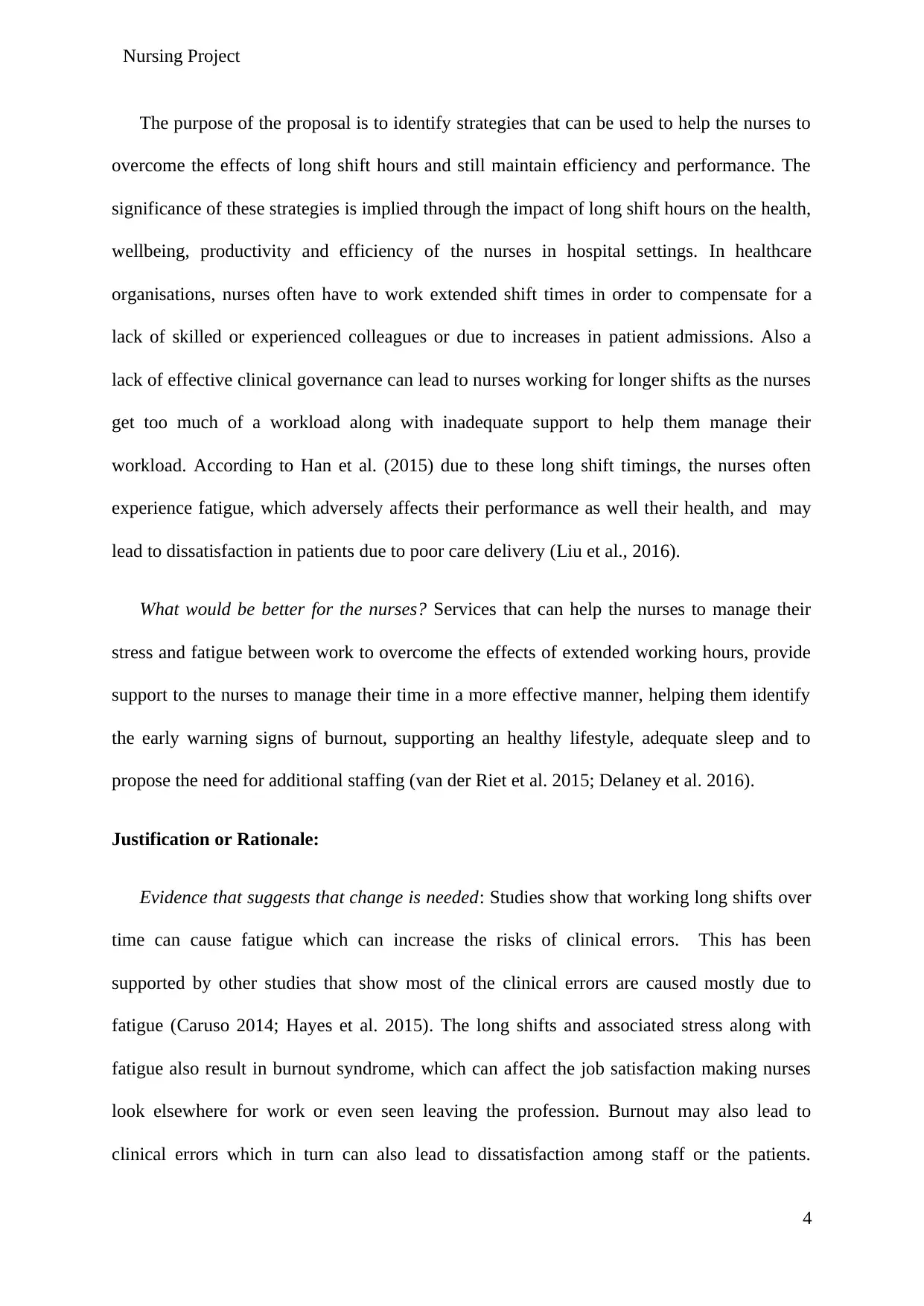
Nursing Project
The purpose of the proposal is to identify strategies that can be used to help the nurses to
overcome the effects of long shift hours and still maintain efficiency and performance. The
significance of these strategies is implied through the impact of long shift hours on the health,
wellbeing, productivity and efficiency of the nurses in hospital settings. In healthcare
organisations, nurses often have to work extended shift times in order to compensate for a
lack of skilled or experienced colleagues or due to increases in patient admissions. Also a
lack of effective clinical governance can lead to nurses working for longer shifts as the nurses
get too much of a workload along with inadequate support to help them manage their
workload. According to Han et al. (2015) due to these long shift timings, the nurses often
experience fatigue, which adversely affects their performance as well their health, and may
lead to dissatisfaction in patients due to poor care delivery (Liu et al., 2016).
What would be better for the nurses? Services that can help the nurses to manage their
stress and fatigue between work to overcome the effects of extended working hours, provide
support to the nurses to manage their time in a more effective manner, helping them identify
the early warning signs of burnout, supporting an healthy lifestyle, adequate sleep and to
propose the need for additional staffing (van der Riet et al. 2015; Delaney et al. 2016).
Justification or Rationale:
Evidence that suggests that change is needed: Studies show that working long shifts over
time can cause fatigue which can increase the risks of clinical errors. This has been
supported by other studies that show most of the clinical errors are caused mostly due to
fatigue (Caruso 2014; Hayes et al. 2015). The long shifts and associated stress along with
fatigue also result in burnout syndrome, which can affect the job satisfaction making nurses
look elsewhere for work or even seen leaving the profession. Burnout may also lead to
clinical errors which in turn can also lead to dissatisfaction among staff or the patients.
4
The purpose of the proposal is to identify strategies that can be used to help the nurses to
overcome the effects of long shift hours and still maintain efficiency and performance. The
significance of these strategies is implied through the impact of long shift hours on the health,
wellbeing, productivity and efficiency of the nurses in hospital settings. In healthcare
organisations, nurses often have to work extended shift times in order to compensate for a
lack of skilled or experienced colleagues or due to increases in patient admissions. Also a
lack of effective clinical governance can lead to nurses working for longer shifts as the nurses
get too much of a workload along with inadequate support to help them manage their
workload. According to Han et al. (2015) due to these long shift timings, the nurses often
experience fatigue, which adversely affects their performance as well their health, and may
lead to dissatisfaction in patients due to poor care delivery (Liu et al., 2016).
What would be better for the nurses? Services that can help the nurses to manage their
stress and fatigue between work to overcome the effects of extended working hours, provide
support to the nurses to manage their time in a more effective manner, helping them identify
the early warning signs of burnout, supporting an healthy lifestyle, adequate sleep and to
propose the need for additional staffing (van der Riet et al. 2015; Delaney et al. 2016).
Justification or Rationale:
Evidence that suggests that change is needed: Studies show that working long shifts over
time can cause fatigue which can increase the risks of clinical errors. This has been
supported by other studies that show most of the clinical errors are caused mostly due to
fatigue (Caruso 2014; Hayes et al. 2015). The long shifts and associated stress along with
fatigue also result in burnout syndrome, which can affect the job satisfaction making nurses
look elsewhere for work or even seen leaving the profession. Burnout may also lead to
clinical errors which in turn can also lead to dissatisfaction among staff or the patients.
4
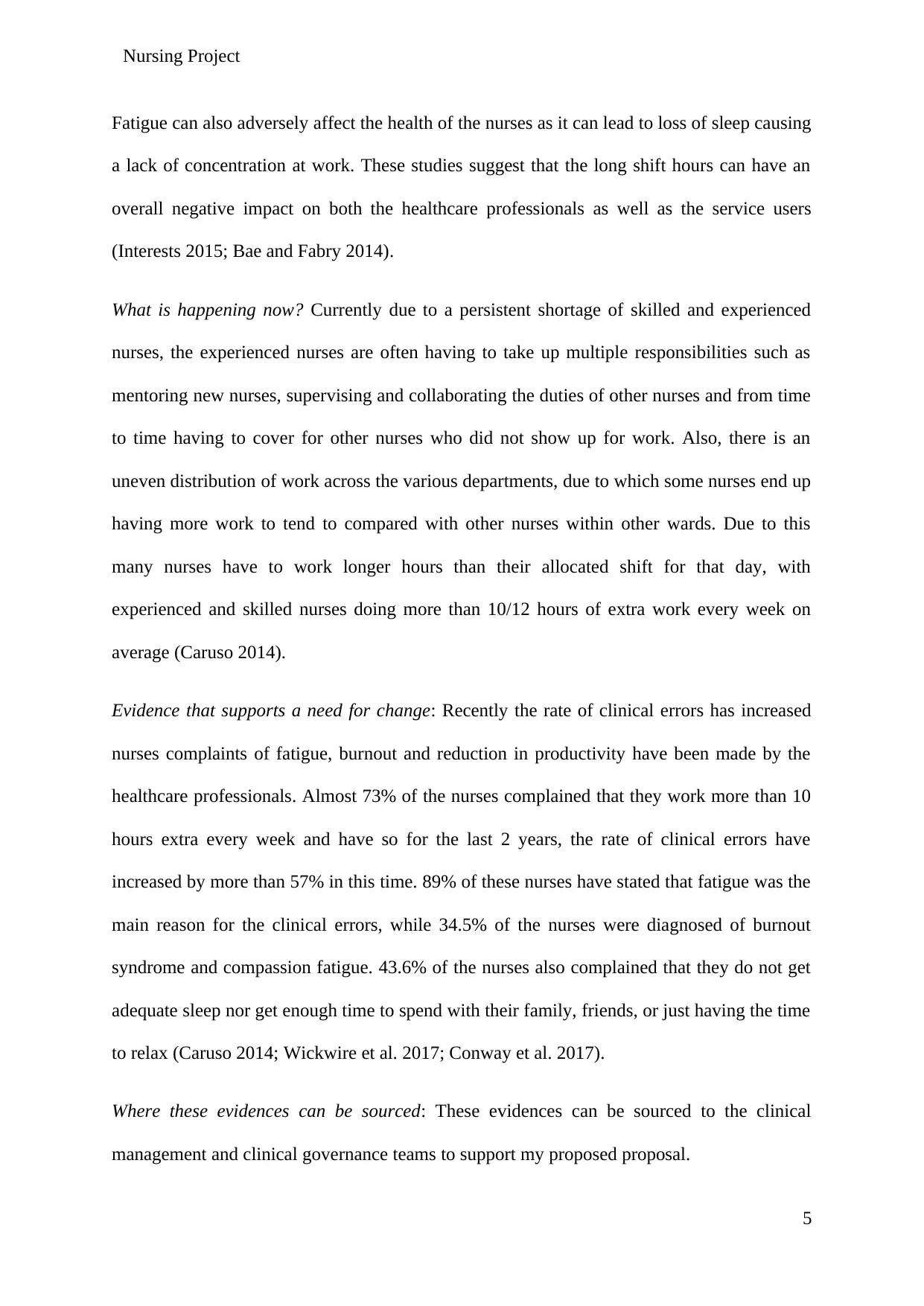
Nursing Project
Fatigue can also adversely affect the health of the nurses as it can lead to loss of sleep causing
a lack of concentration at work. These studies suggest that the long shift hours can have an
overall negative impact on both the healthcare professionals as well as the service users
(Interests 2015; Bae and Fabry 2014).
What is happening now? Currently due to a persistent shortage of skilled and experienced
nurses, the experienced nurses are often having to take up multiple responsibilities such as
mentoring new nurses, supervising and collaborating the duties of other nurses and from time
to time having to cover for other nurses who did not show up for work. Also, there is an
uneven distribution of work across the various departments, due to which some nurses end up
having more work to tend to compared with other nurses within other wards. Due to this
many nurses have to work longer hours than their allocated shift for that day, with
experienced and skilled nurses doing more than 10/12 hours of extra work every week on
average (Caruso 2014).
Evidence that supports a need for change: Recently the rate of clinical errors has increased
nurses complaints of fatigue, burnout and reduction in productivity have been made by the
healthcare professionals. Almost 73% of the nurses complained that they work more than 10
hours extra every week and have so for the last 2 years, the rate of clinical errors have
increased by more than 57% in this time. 89% of these nurses have stated that fatigue was the
main reason for the clinical errors, while 34.5% of the nurses were diagnosed of burnout
syndrome and compassion fatigue. 43.6% of the nurses also complained that they do not get
adequate sleep nor get enough time to spend with their family, friends, or just having the time
to relax (Caruso 2014; Wickwire et al. 2017; Conway et al. 2017).
Where these evidences can be sourced: These evidences can be sourced to the clinical
management and clinical governance teams to support my proposed proposal.
5
Fatigue can also adversely affect the health of the nurses as it can lead to loss of sleep causing
a lack of concentration at work. These studies suggest that the long shift hours can have an
overall negative impact on both the healthcare professionals as well as the service users
(Interests 2015; Bae and Fabry 2014).
What is happening now? Currently due to a persistent shortage of skilled and experienced
nurses, the experienced nurses are often having to take up multiple responsibilities such as
mentoring new nurses, supervising and collaborating the duties of other nurses and from time
to time having to cover for other nurses who did not show up for work. Also, there is an
uneven distribution of work across the various departments, due to which some nurses end up
having more work to tend to compared with other nurses within other wards. Due to this
many nurses have to work longer hours than their allocated shift for that day, with
experienced and skilled nurses doing more than 10/12 hours of extra work every week on
average (Caruso 2014).
Evidence that supports a need for change: Recently the rate of clinical errors has increased
nurses complaints of fatigue, burnout and reduction in productivity have been made by the
healthcare professionals. Almost 73% of the nurses complained that they work more than 10
hours extra every week and have so for the last 2 years, the rate of clinical errors have
increased by more than 57% in this time. 89% of these nurses have stated that fatigue was the
main reason for the clinical errors, while 34.5% of the nurses were diagnosed of burnout
syndrome and compassion fatigue. 43.6% of the nurses also complained that they do not get
adequate sleep nor get enough time to spend with their family, friends, or just having the time
to relax (Caruso 2014; Wickwire et al. 2017; Conway et al. 2017).
Where these evidences can be sourced: These evidences can be sourced to the clinical
management and clinical governance teams to support my proposed proposal.
5
⊘ This is a preview!⊘
Do you want full access?
Subscribe today to unlock all pages.

Trusted by 1+ million students worldwide
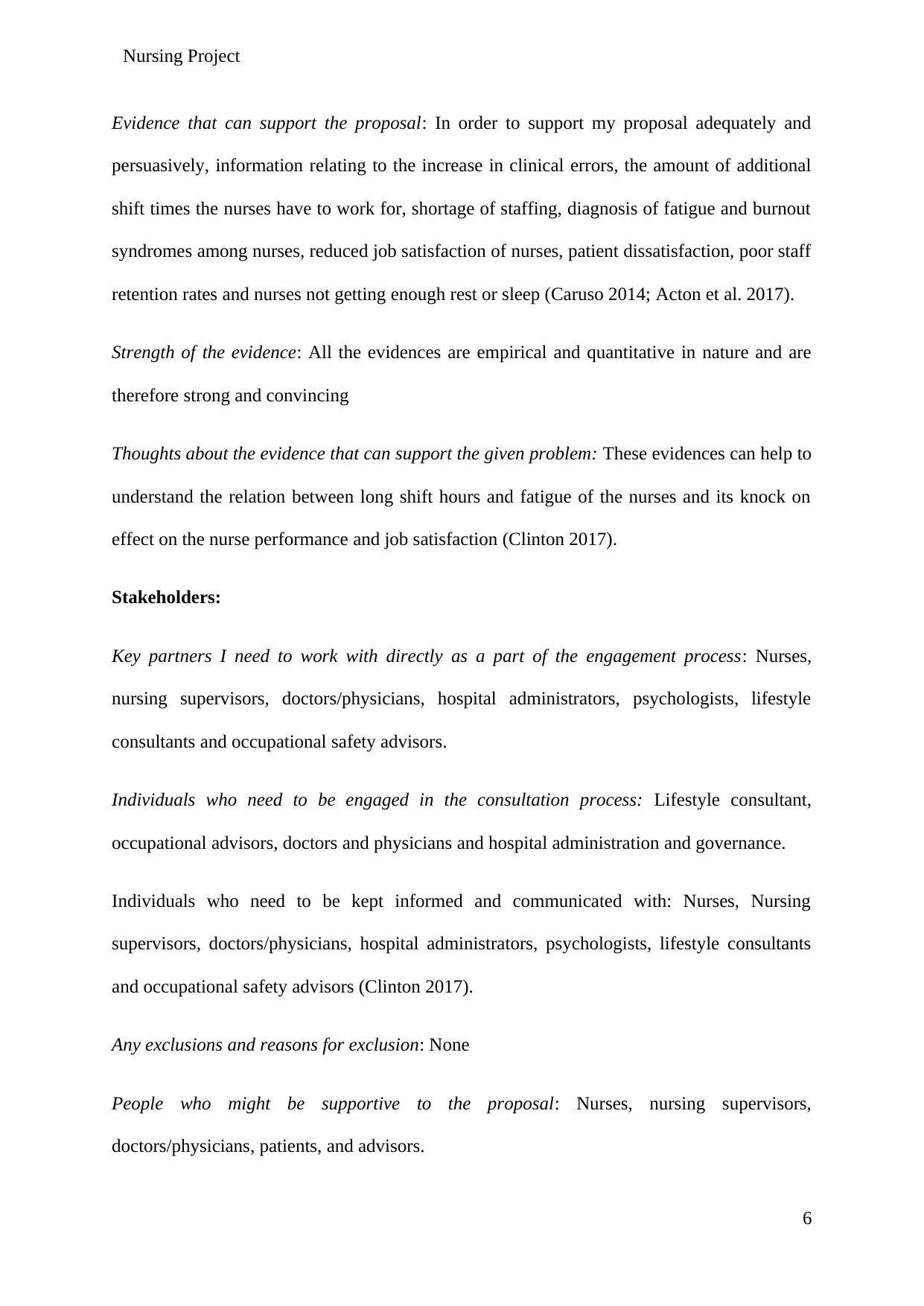
Nursing Project
Evidence that can support the proposal: In order to support my proposal adequately and
persuasively, information relating to the increase in clinical errors, the amount of additional
shift times the nurses have to work for, shortage of staffing, diagnosis of fatigue and burnout
syndromes among nurses, reduced job satisfaction of nurses, patient dissatisfaction, poor staff
retention rates and nurses not getting enough rest or sleep (Caruso 2014; Acton et al. 2017).
Strength of the evidence: All the evidences are empirical and quantitative in nature and are
therefore strong and convincing
Thoughts about the evidence that can support the given problem: These evidences can help to
understand the relation between long shift hours and fatigue of the nurses and its knock on
effect on the nurse performance and job satisfaction (Clinton 2017).
Stakeholders:
Key partners I need to work with directly as a part of the engagement process: Nurses,
nursing supervisors, doctors/physicians, hospital administrators, psychologists, lifestyle
consultants and occupational safety advisors.
Individuals who need to be engaged in the consultation process: Lifestyle consultant,
occupational advisors, doctors and physicians and hospital administration and governance.
Individuals who need to be kept informed and communicated with: Nurses, Nursing
supervisors, doctors/physicians, hospital administrators, psychologists, lifestyle consultants
and occupational safety advisors (Clinton 2017).
Any exclusions and reasons for exclusion: None
People who might be supportive to the proposal: Nurses, nursing supervisors,
doctors/physicians, patients, and advisors.
6
Evidence that can support the proposal: In order to support my proposal adequately and
persuasively, information relating to the increase in clinical errors, the amount of additional
shift times the nurses have to work for, shortage of staffing, diagnosis of fatigue and burnout
syndromes among nurses, reduced job satisfaction of nurses, patient dissatisfaction, poor staff
retention rates and nurses not getting enough rest or sleep (Caruso 2014; Acton et al. 2017).
Strength of the evidence: All the evidences are empirical and quantitative in nature and are
therefore strong and convincing
Thoughts about the evidence that can support the given problem: These evidences can help to
understand the relation between long shift hours and fatigue of the nurses and its knock on
effect on the nurse performance and job satisfaction (Clinton 2017).
Stakeholders:
Key partners I need to work with directly as a part of the engagement process: Nurses,
nursing supervisors, doctors/physicians, hospital administrators, psychologists, lifestyle
consultants and occupational safety advisors.
Individuals who need to be engaged in the consultation process: Lifestyle consultant,
occupational advisors, doctors and physicians and hospital administration and governance.
Individuals who need to be kept informed and communicated with: Nurses, Nursing
supervisors, doctors/physicians, hospital administrators, psychologists, lifestyle consultants
and occupational safety advisors (Clinton 2017).
Any exclusions and reasons for exclusion: None
People who might be supportive to the proposal: Nurses, nursing supervisors,
doctors/physicians, patients, and advisors.
6
Paraphrase This Document
Need a fresh take? Get an instant paraphrase of this document with our AI Paraphraser
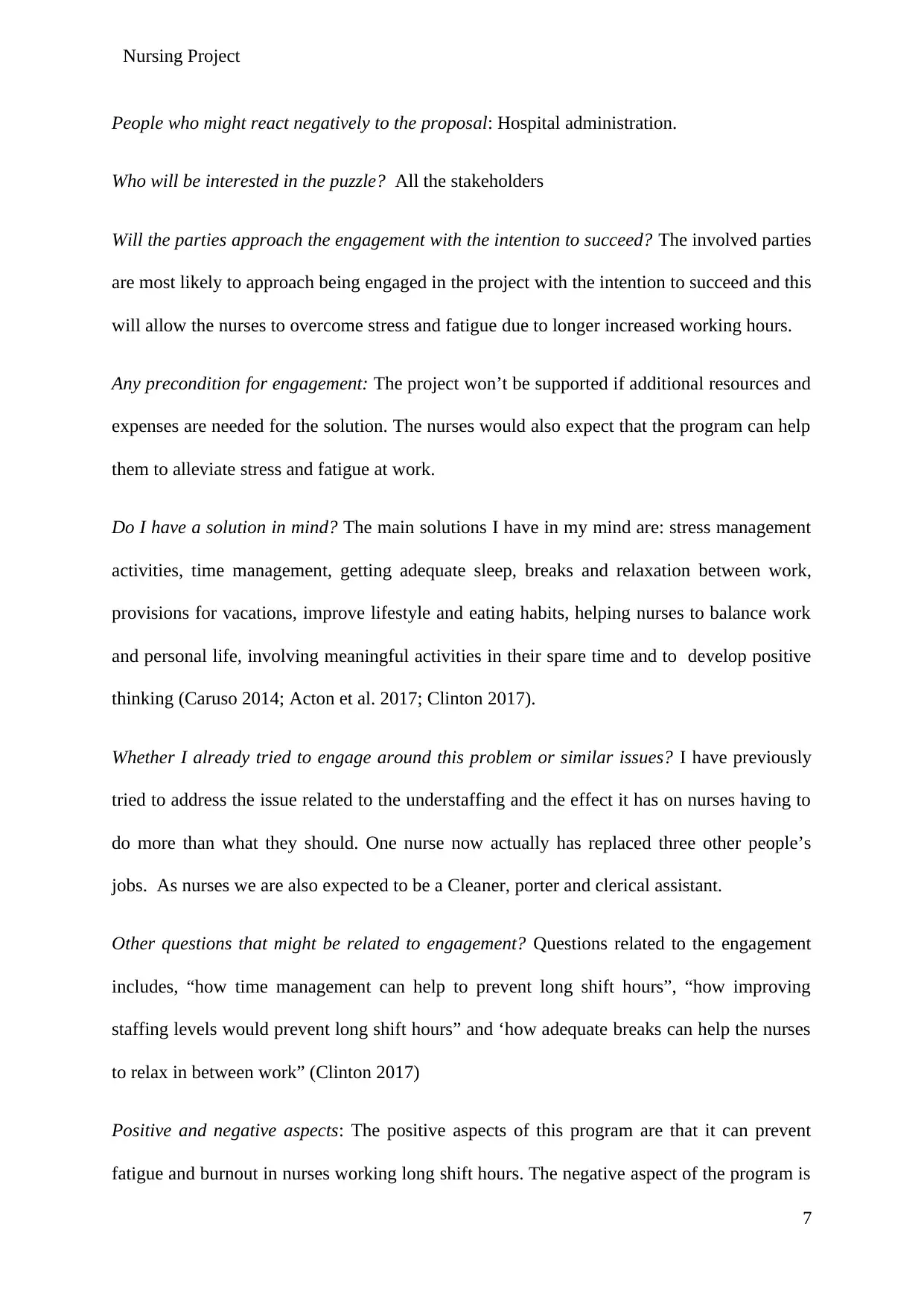
Nursing Project
People who might react negatively to the proposal: Hospital administration.
Who will be interested in the puzzle? All the stakeholders
Will the parties approach the engagement with the intention to succeed? The involved parties
are most likely to approach being engaged in the project with the intention to succeed and this
will allow the nurses to overcome stress and fatigue due to longer increased working hours.
Any precondition for engagement: The project won’t be supported if additional resources and
expenses are needed for the solution. The nurses would also expect that the program can help
them to alleviate stress and fatigue at work.
Do I have a solution in mind? The main solutions I have in my mind are: stress management
activities, time management, getting adequate sleep, breaks and relaxation between work,
provisions for vacations, improve lifestyle and eating habits, helping nurses to balance work
and personal life, involving meaningful activities in their spare time and to develop positive
thinking (Caruso 2014; Acton et al. 2017; Clinton 2017).
Whether I already tried to engage around this problem or similar issues? I have previously
tried to address the issue related to the understaffing and the effect it has on nurses having to
do more than what they should. One nurse now actually has replaced three other people’s
jobs. As nurses we are also expected to be a Cleaner, porter and clerical assistant.
Other questions that might be related to engagement? Questions related to the engagement
includes, “how time management can help to prevent long shift hours”, “how improving
staffing levels would prevent long shift hours” and ‘how adequate breaks can help the nurses
to relax in between work” (Clinton 2017)
Positive and negative aspects: The positive aspects of this program are that it can prevent
fatigue and burnout in nurses working long shift hours. The negative aspect of the program is
7
People who might react negatively to the proposal: Hospital administration.
Who will be interested in the puzzle? All the stakeholders
Will the parties approach the engagement with the intention to succeed? The involved parties
are most likely to approach being engaged in the project with the intention to succeed and this
will allow the nurses to overcome stress and fatigue due to longer increased working hours.
Any precondition for engagement: The project won’t be supported if additional resources and
expenses are needed for the solution. The nurses would also expect that the program can help
them to alleviate stress and fatigue at work.
Do I have a solution in mind? The main solutions I have in my mind are: stress management
activities, time management, getting adequate sleep, breaks and relaxation between work,
provisions for vacations, improve lifestyle and eating habits, helping nurses to balance work
and personal life, involving meaningful activities in their spare time and to develop positive
thinking (Caruso 2014; Acton et al. 2017; Clinton 2017).
Whether I already tried to engage around this problem or similar issues? I have previously
tried to address the issue related to the understaffing and the effect it has on nurses having to
do more than what they should. One nurse now actually has replaced three other people’s
jobs. As nurses we are also expected to be a Cleaner, porter and clerical assistant.
Other questions that might be related to engagement? Questions related to the engagement
includes, “how time management can help to prevent long shift hours”, “how improving
staffing levels would prevent long shift hours” and ‘how adequate breaks can help the nurses
to relax in between work” (Clinton 2017)
Positive and negative aspects: The positive aspects of this program are that it can prevent
fatigue and burnout in nurses working long shift hours. The negative aspect of the program is
7
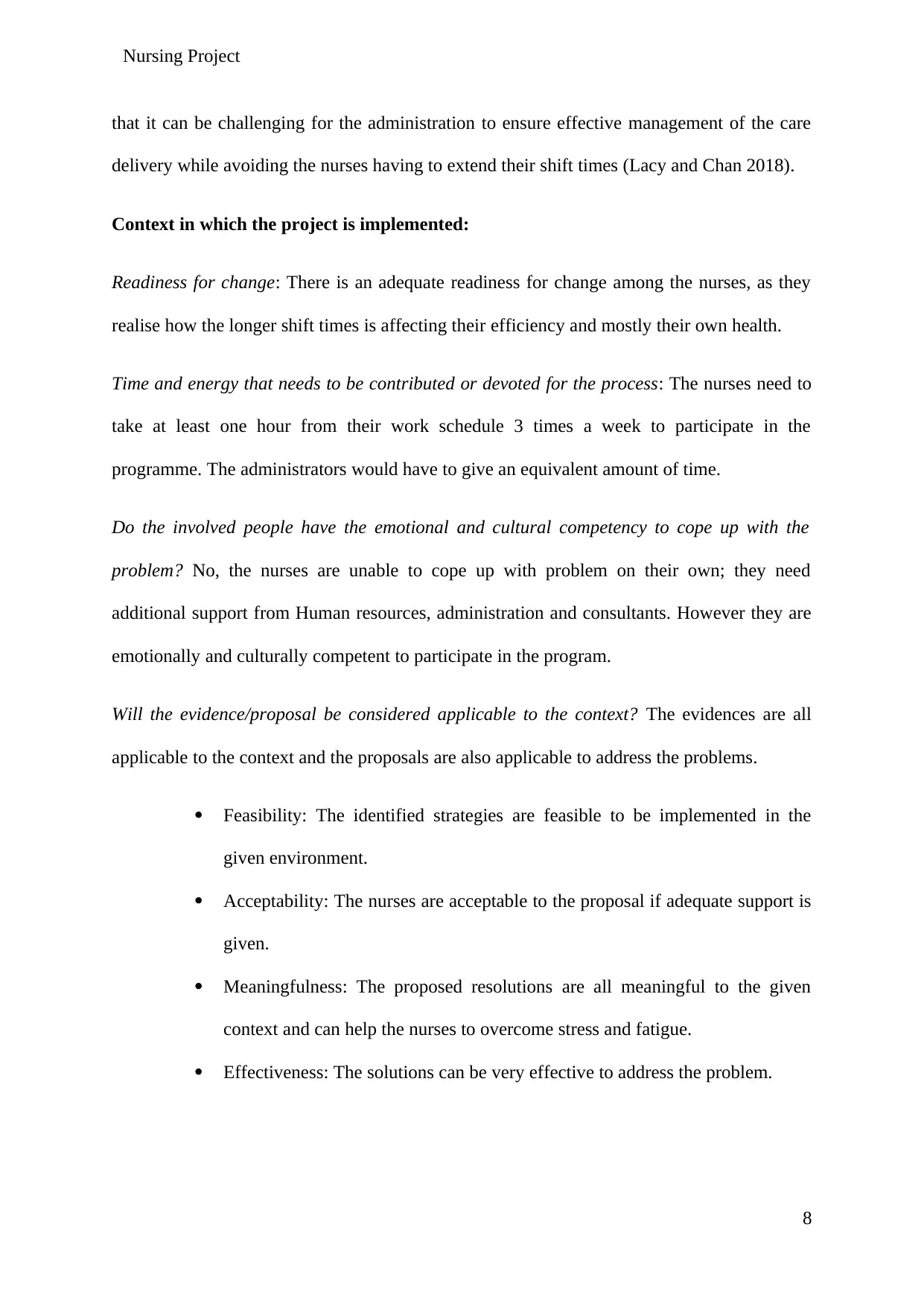
Nursing Project
that it can be challenging for the administration to ensure effective management of the care
delivery while avoiding the nurses having to extend their shift times (Lacy and Chan 2018).
Context in which the project is implemented:
Readiness for change: There is an adequate readiness for change among the nurses, as they
realise how the longer shift times is affecting their efficiency and mostly their own health.
Time and energy that needs to be contributed or devoted for the process: The nurses need to
take at least one hour from their work schedule 3 times a week to participate in the
programme. The administrators would have to give an equivalent amount of time.
Do the involved people have the emotional and cultural competency to cope up with the
problem? No, the nurses are unable to cope up with problem on their own; they need
additional support from Human resources, administration and consultants. However they are
emotionally and culturally competent to participate in the program.
Will the evidence/proposal be considered applicable to the context? The evidences are all
applicable to the context and the proposals are also applicable to address the problems.
Feasibility: The identified strategies are feasible to be implemented in the
given environment.
Acceptability: The nurses are acceptable to the proposal if adequate support is
given.
Meaningfulness: The proposed resolutions are all meaningful to the given
context and can help the nurses to overcome stress and fatigue.
Effectiveness: The solutions can be very effective to address the problem.
8
that it can be challenging for the administration to ensure effective management of the care
delivery while avoiding the nurses having to extend their shift times (Lacy and Chan 2018).
Context in which the project is implemented:
Readiness for change: There is an adequate readiness for change among the nurses, as they
realise how the longer shift times is affecting their efficiency and mostly their own health.
Time and energy that needs to be contributed or devoted for the process: The nurses need to
take at least one hour from their work schedule 3 times a week to participate in the
programme. The administrators would have to give an equivalent amount of time.
Do the involved people have the emotional and cultural competency to cope up with the
problem? No, the nurses are unable to cope up with problem on their own; they need
additional support from Human resources, administration and consultants. However they are
emotionally and culturally competent to participate in the program.
Will the evidence/proposal be considered applicable to the context? The evidences are all
applicable to the context and the proposals are also applicable to address the problems.
Feasibility: The identified strategies are feasible to be implemented in the
given environment.
Acceptability: The nurses are acceptable to the proposal if adequate support is
given.
Meaningfulness: The proposed resolutions are all meaningful to the given
context and can help the nurses to overcome stress and fatigue.
Effectiveness: The solutions can be very effective to address the problem.
8
⊘ This is a preview!⊘
Do you want full access?
Subscribe today to unlock all pages.

Trusted by 1+ million students worldwide
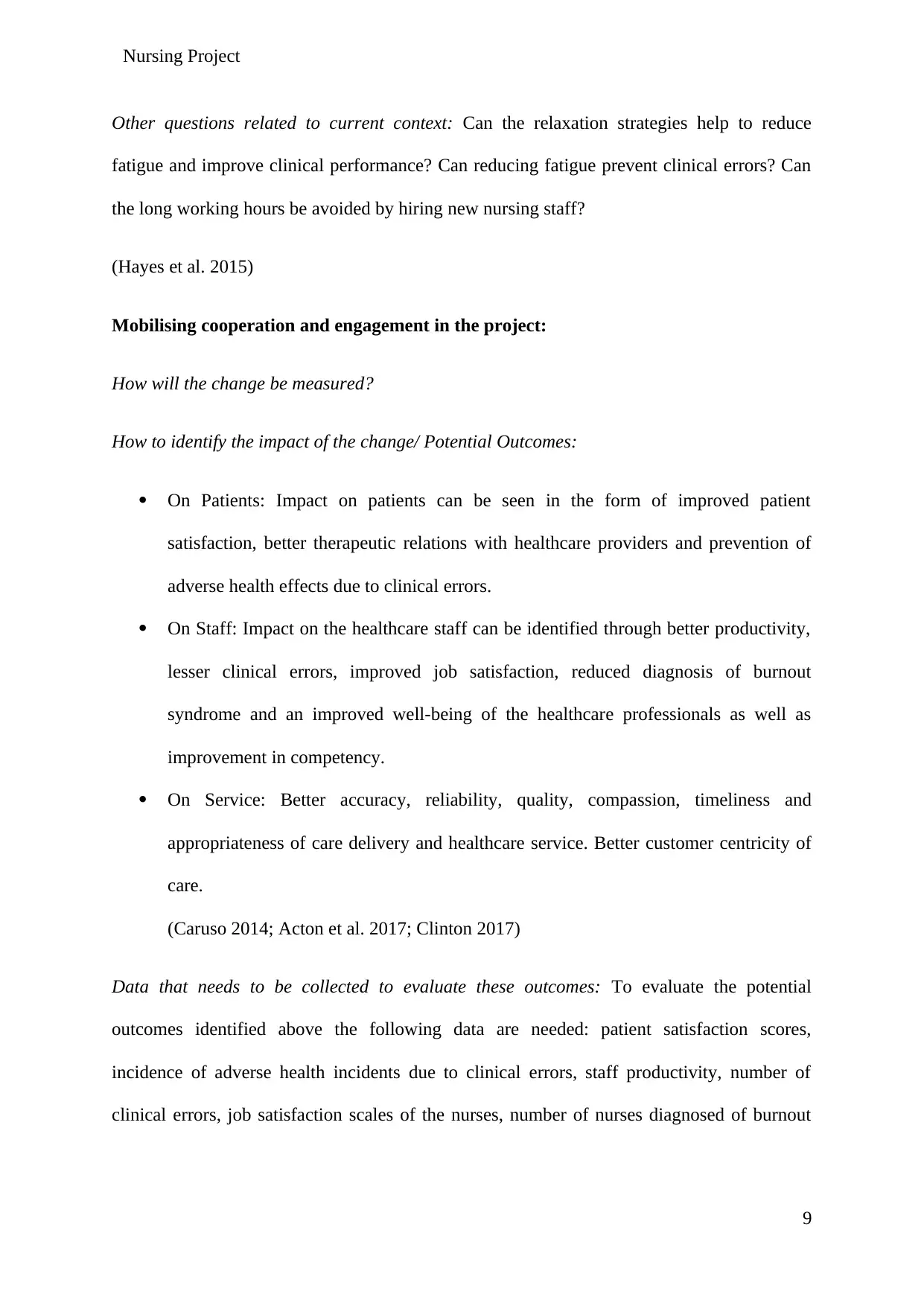
Nursing Project
Other questions related to current context: Can the relaxation strategies help to reduce
fatigue and improve clinical performance? Can reducing fatigue prevent clinical errors? Can
the long working hours be avoided by hiring new nursing staff?
(Hayes et al. 2015)
Mobilising cooperation and engagement in the project:
How will the change be measured?
How to identify the impact of the change/ Potential Outcomes:
On Patients: Impact on patients can be seen in the form of improved patient
satisfaction, better therapeutic relations with healthcare providers and prevention of
adverse health effects due to clinical errors.
On Staff: Impact on the healthcare staff can be identified through better productivity,
lesser clinical errors, improved job satisfaction, reduced diagnosis of burnout
syndrome and an improved well-being of the healthcare professionals as well as
improvement in competency.
On Service: Better accuracy, reliability, quality, compassion, timeliness and
appropriateness of care delivery and healthcare service. Better customer centricity of
care.
(Caruso 2014; Acton et al. 2017; Clinton 2017)
Data that needs to be collected to evaluate these outcomes: To evaluate the potential
outcomes identified above the following data are needed: patient satisfaction scores,
incidence of adverse health incidents due to clinical errors, staff productivity, number of
clinical errors, job satisfaction scales of the nurses, number of nurses diagnosed of burnout
9
Other questions related to current context: Can the relaxation strategies help to reduce
fatigue and improve clinical performance? Can reducing fatigue prevent clinical errors? Can
the long working hours be avoided by hiring new nursing staff?
(Hayes et al. 2015)
Mobilising cooperation and engagement in the project:
How will the change be measured?
How to identify the impact of the change/ Potential Outcomes:
On Patients: Impact on patients can be seen in the form of improved patient
satisfaction, better therapeutic relations with healthcare providers and prevention of
adverse health effects due to clinical errors.
On Staff: Impact on the healthcare staff can be identified through better productivity,
lesser clinical errors, improved job satisfaction, reduced diagnosis of burnout
syndrome and an improved well-being of the healthcare professionals as well as
improvement in competency.
On Service: Better accuracy, reliability, quality, compassion, timeliness and
appropriateness of care delivery and healthcare service. Better customer centricity of
care.
(Caruso 2014; Acton et al. 2017; Clinton 2017)
Data that needs to be collected to evaluate these outcomes: To evaluate the potential
outcomes identified above the following data are needed: patient satisfaction scores,
incidence of adverse health incidents due to clinical errors, staff productivity, number of
clinical errors, job satisfaction scales of the nurses, number of nurses diagnosed of burnout
9
Paraphrase This Document
Need a fresh take? Get an instant paraphrase of this document with our AI Paraphraser
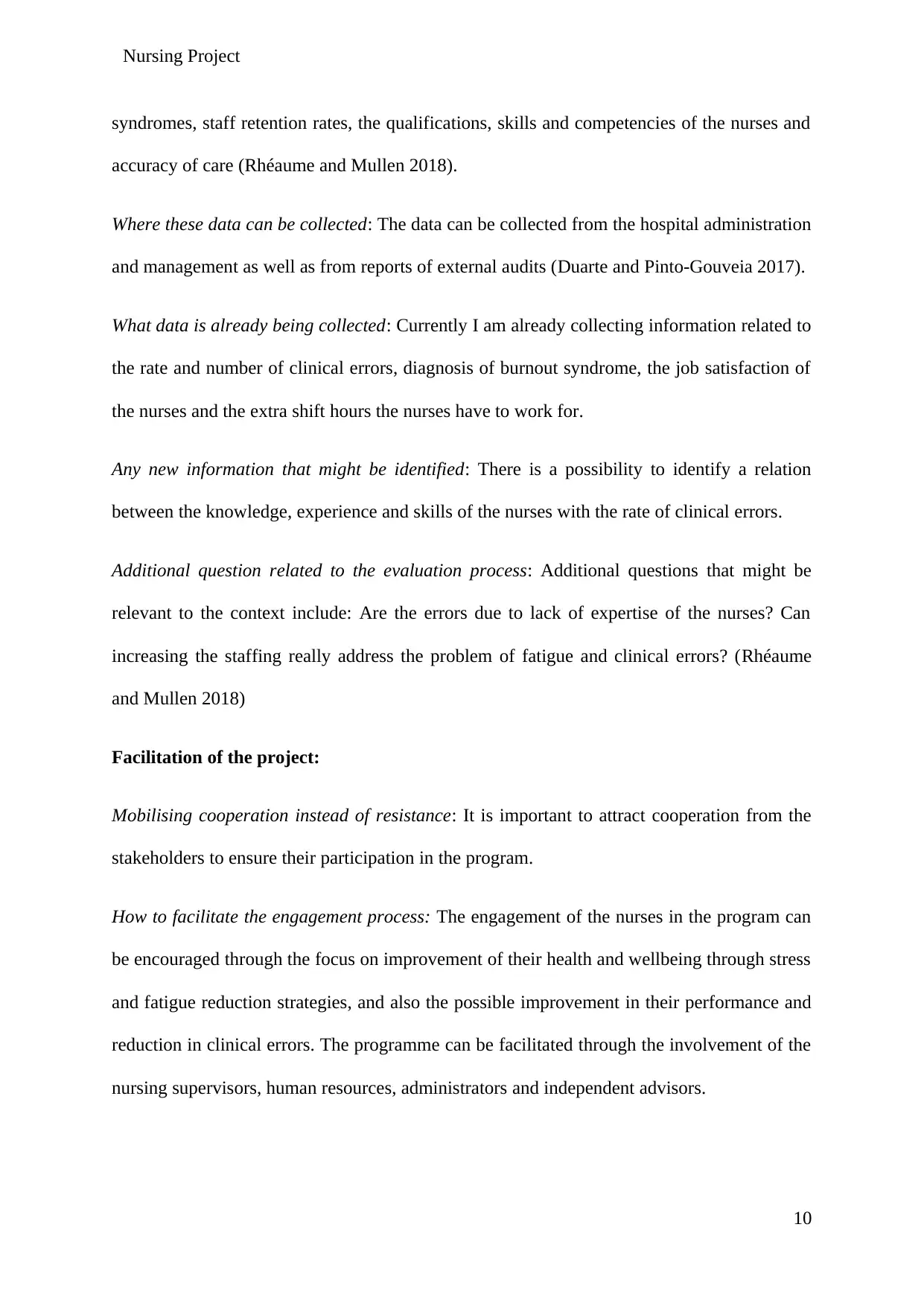
Nursing Project
syndromes, staff retention rates, the qualifications, skills and competencies of the nurses and
accuracy of care (Rhéaume and Mullen 2018).
Where these data can be collected: The data can be collected from the hospital administration
and management as well as from reports of external audits (Duarte and Pinto-Gouveia 2017).
What data is already being collected: Currently I am already collecting information related to
the rate and number of clinical errors, diagnosis of burnout syndrome, the job satisfaction of
the nurses and the extra shift hours the nurses have to work for.
Any new information that might be identified: There is a possibility to identify a relation
between the knowledge, experience and skills of the nurses with the rate of clinical errors.
Additional question related to the evaluation process: Additional questions that might be
relevant to the context include: Are the errors due to lack of expertise of the nurses? Can
increasing the staffing really address the problem of fatigue and clinical errors? (Rhéaume
and Mullen 2018)
Facilitation of the project:
Mobilising cooperation instead of resistance: It is important to attract cooperation from the
stakeholders to ensure their participation in the program.
How to facilitate the engagement process: The engagement of the nurses in the program can
be encouraged through the focus on improvement of their health and wellbeing through stress
and fatigue reduction strategies, and also the possible improvement in their performance and
reduction in clinical errors. The programme can be facilitated through the involvement of the
nursing supervisors, human resources, administrators and independent advisors.
10
syndromes, staff retention rates, the qualifications, skills and competencies of the nurses and
accuracy of care (Rhéaume and Mullen 2018).
Where these data can be collected: The data can be collected from the hospital administration
and management as well as from reports of external audits (Duarte and Pinto-Gouveia 2017).
What data is already being collected: Currently I am already collecting information related to
the rate and number of clinical errors, diagnosis of burnout syndrome, the job satisfaction of
the nurses and the extra shift hours the nurses have to work for.
Any new information that might be identified: There is a possibility to identify a relation
between the knowledge, experience and skills of the nurses with the rate of clinical errors.
Additional question related to the evaluation process: Additional questions that might be
relevant to the context include: Are the errors due to lack of expertise of the nurses? Can
increasing the staffing really address the problem of fatigue and clinical errors? (Rhéaume
and Mullen 2018)
Facilitation of the project:
Mobilising cooperation instead of resistance: It is important to attract cooperation from the
stakeholders to ensure their participation in the program.
How to facilitate the engagement process: The engagement of the nurses in the program can
be encouraged through the focus on improvement of their health and wellbeing through stress
and fatigue reduction strategies, and also the possible improvement in their performance and
reduction in clinical errors. The programme can be facilitated through the involvement of the
nursing supervisors, human resources, administrators and independent advisors.
10
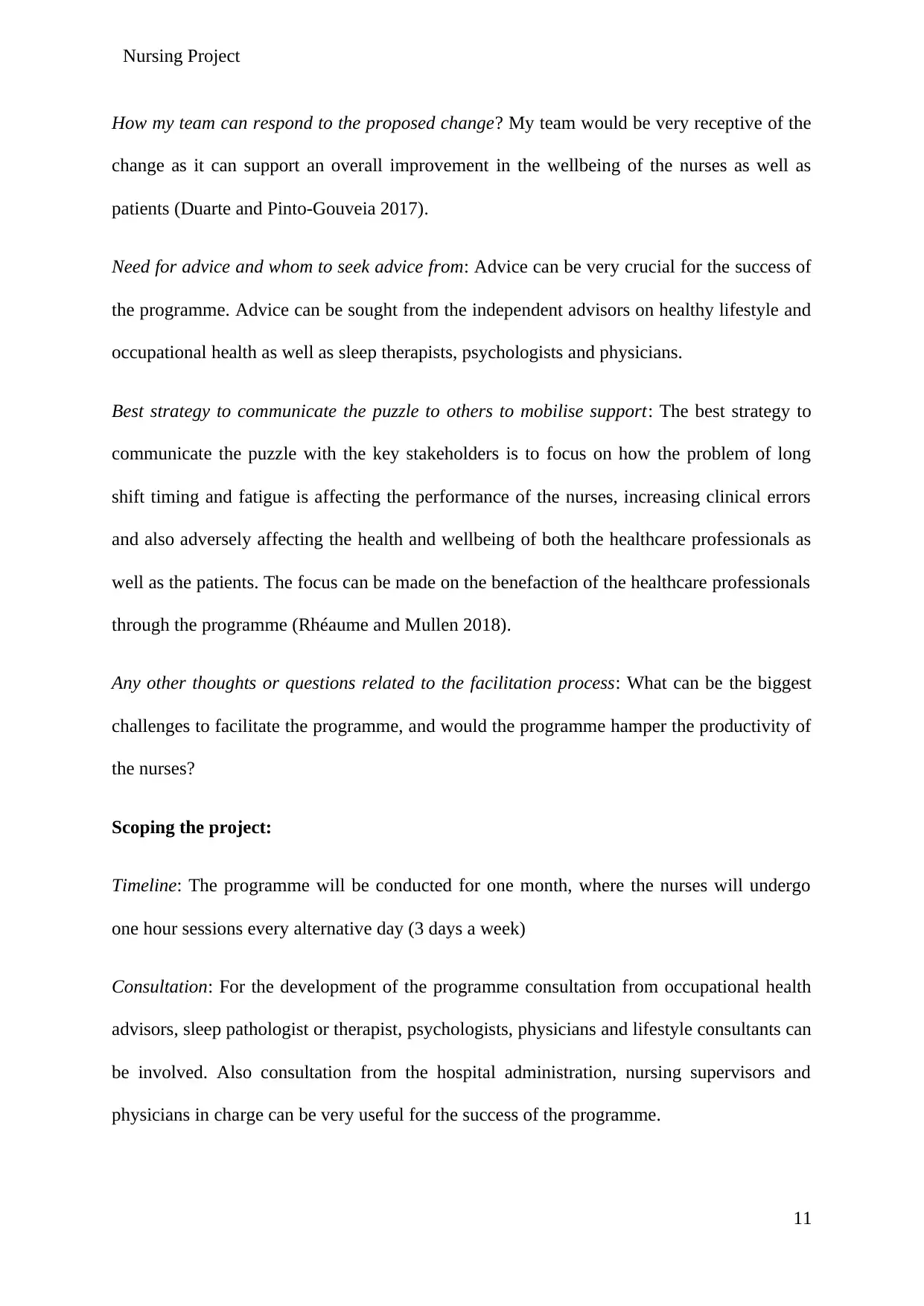
Nursing Project
How my team can respond to the proposed change? My team would be very receptive of the
change as it can support an overall improvement in the wellbeing of the nurses as well as
patients (Duarte and Pinto-Gouveia 2017).
Need for advice and whom to seek advice from: Advice can be very crucial for the success of
the programme. Advice can be sought from the independent advisors on healthy lifestyle and
occupational health as well as sleep therapists, psychologists and physicians.
Best strategy to communicate the puzzle to others to mobilise support: The best strategy to
communicate the puzzle with the key stakeholders is to focus on how the problem of long
shift timing and fatigue is affecting the performance of the nurses, increasing clinical errors
and also adversely affecting the health and wellbeing of both the healthcare professionals as
well as the patients. The focus can be made on the benefaction of the healthcare professionals
through the programme (Rhéaume and Mullen 2018).
Any other thoughts or questions related to the facilitation process: What can be the biggest
challenges to facilitate the programme, and would the programme hamper the productivity of
the nurses?
Scoping the project:
Timeline: The programme will be conducted for one month, where the nurses will undergo
one hour sessions every alternative day (3 days a week)
Consultation: For the development of the programme consultation from occupational health
advisors, sleep pathologist or therapist, psychologists, physicians and lifestyle consultants can
be involved. Also consultation from the hospital administration, nursing supervisors and
physicians in charge can be very useful for the success of the programme.
11
How my team can respond to the proposed change? My team would be very receptive of the
change as it can support an overall improvement in the wellbeing of the nurses as well as
patients (Duarte and Pinto-Gouveia 2017).
Need for advice and whom to seek advice from: Advice can be very crucial for the success of
the programme. Advice can be sought from the independent advisors on healthy lifestyle and
occupational health as well as sleep therapists, psychologists and physicians.
Best strategy to communicate the puzzle to others to mobilise support: The best strategy to
communicate the puzzle with the key stakeholders is to focus on how the problem of long
shift timing and fatigue is affecting the performance of the nurses, increasing clinical errors
and also adversely affecting the health and wellbeing of both the healthcare professionals as
well as the patients. The focus can be made on the benefaction of the healthcare professionals
through the programme (Rhéaume and Mullen 2018).
Any other thoughts or questions related to the facilitation process: What can be the biggest
challenges to facilitate the programme, and would the programme hamper the productivity of
the nurses?
Scoping the project:
Timeline: The programme will be conducted for one month, where the nurses will undergo
one hour sessions every alternative day (3 days a week)
Consultation: For the development of the programme consultation from occupational health
advisors, sleep pathologist or therapist, psychologists, physicians and lifestyle consultants can
be involved. Also consultation from the hospital administration, nursing supervisors and
physicians in charge can be very useful for the success of the programme.
11
⊘ This is a preview!⊘
Do you want full access?
Subscribe today to unlock all pages.

Trusted by 1+ million students worldwide
1 out of 21
Related Documents
Your All-in-One AI-Powered Toolkit for Academic Success.
+13062052269
info@desklib.com
Available 24*7 on WhatsApp / Email
![[object Object]](/_next/static/media/star-bottom.7253800d.svg)
Unlock your academic potential
Copyright © 2020–2025 A2Z Services. All Rights Reserved. Developed and managed by ZUCOL.





![NURSING CASE STUDY: CRITICAL DISCUSSION - [University Name]](/_next/image/?url=https%3A%2F%2Fdesklib.com%2Fmedia%2Fimages%2Fqz%2F1da4b808cec246569d94252e4c61b71e.jpg&w=256&q=75)